The Development of Skills as a Key Factor of the Cooperative System: Analysis of the Cooperative of Artisan Women Tejemujeres-Gualaceo-Ecuador from the WWP Model
Abstract
1. Introduction
2. Theoretical Background
2.1. Cooperativism and Local/Rural Development
2.2. The “Working with People” Model and the IPMA Competencies as Skills Development Analysis Tools
3. Methods
3.1. Case Study
3.1.1. Current Situation of the Gualaceo Canton
3.1.2. History and Constitution of the Tejemujeres Cooperative
3.1.3. Institutional Achievements in the Tejemujeres Timeline
3.2. Application of the Questionnaire
3.3. Questionnaire Validation
4. Results
4.1. Sample
4.2. Item Analysis
4.3. Reliability
4.4. Political—Contextual Dimension
4.5. Social Ethics Dimension
4.6. Technical-Business Dimension
5. Discussion of Results
6. Conclusions
Author Contributions
Funding
Institutional Review Board Statement
Conflicts of Interest
References
- Uluate, J. Orientación laboral: Una revisión bibliográfica de su conceptualización y su aporte a la persona trabajadora ya las organizaciones laborales. Rev. Electrónica Educ. 2017, 21, 397–413. [Google Scholar]
- Eum, H.S. CICOPA. Second Global Report on “Cooperatives and Employment”. 2017. Available online: https://www.cicopa.coop/es/publications/second-global-report-on-cooperatives-and-employment/ (accessed on 26 September 2022).
- Kwan, B.; Frankish, J.; Quantz, D.; Flores, J. A Synthesis Paper on the Conceptualization and Measurement of Community Capacity; UBC Institute of Health Promotion Research, University of British Columbia: Vancouver, BC, Canada, 2003. [Google Scholar]
- Calvopiña, A. Cooperativismo en el Ecuador. Eko 2019, 12. Available online: https://www.ekosnegocios.com/articulo/cooperativismo-en-ecuador (accessed on 13 July 2022).
- CEPAL. Comisión Económica para América Latina y el Caribe. In Cooperativismo Latinoamericano: Antecedentes y Perspectivas; CEPAL: Santiago, Chile, 1989. [Google Scholar]
- Luna González, A.; Guzmán Rodríguez, J. Diseño del Modelo de Competencias Para la Cooperativa Gestionando. Coop De La Ciudad De Pereira. Universidad Tecnológica de Pereira. 2011. Available online: https://repositorio.utp.edu.co/server/api/core/bitstreams/5714264d-e424-45de-bd74-844ad4374f8c/content (accessed on 15 July 2022).
- Ramírez Figueroa, C.A. Cooperativismo y Competencias: De la Calificación al Auto Reconocimiento. Universidad Militar Nueva Granada. 2014. Available online: https://repository.unimilitar.edu.co/bitstream/handle/10654/12797/MONOGRAFIA.pdf?sequence=1&isAllowed=y (accessed on 17 July 2022).
- Alianza Cooperativa Internacional (ACI). Exploring the Cooperative Economy. 2022. Available online: https://monitor.coop/sites/default/files/2022-01/WCM_2021_0.pdf (accessed on 28 March 2022).
- Alianza Cooperativa Internacional (ACI). Exploring the Cooperative Economy, Report 2020. 2020. Available online: https://monitor.coop/sites/default/files/publication-files/wcm2020web-final-1083463041.pdf (accessed on 28 March 2022).
- Chaskin, R.J. Building Community Capacity: A Definitional Framework and Case Studies from a Comprehensive Community Initiative. Urban Aff. Rev. 2001, 36, 291–323. [Google Scholar] [CrossRef]
- Izquierdo, M.; Robles, R. Viabilidad de la empresa cooperativa como una empresa humanista del siglo XXI. In Fomento del Cooperativismo como Alternativa Económica y Social Sostenible: Una visión de México y España; Arnáez Arce, V.M., Muciño, M.E., Eds.; Dykinson, S.L.: Madrid, Spain, 2018; pp. 15–32. Available online: https://www.jstor.org/stable/j.ctvfb6zt4 (accessed on 15 July 2022). [CrossRef]
- Organización Internacional del Trabajo (OIT). Desarrollo Rural a Través del Trabajo Decente; Organización Internacional del Trabajo: Madrid, Spain, 2017. [Google Scholar]
- Bustamante, A. Gestión humana socialmente responsable en cooperativas de trabajo asociado colombianas. CIRIEC 2019, 5, 217–255. [Google Scholar] [CrossRef]
- Goodman, R.; Speers, M.; McLeroy, K.; Fawcett, S.; Kegler, M.; Parker, E.; Smith, S.R.; Sterling, T.D.; Wallerstein, N. Identifying and Defining the Dimensions of Community Capacity to Provide a Basis for Measurement. Health Educ. Behav. 1998, 25, 258–278. [Google Scholar] [CrossRef] [PubMed]
- Laverack, G. An identification and interpretation of the organizational aspects of community empowerment. Community Dev. J. 2001, 36, 134–145. [Google Scholar] [CrossRef]
- Rábago, L.E. Gestión por Competencias: Un Enfoque Para Mejorar el Rendimiento Personal y Empresarial; Bussines Pocket; Netbiblo: La Coruña, Spain, 2010. [Google Scholar]
- Egia, G. El modelo cooperativo: Mucho más que una alternativa ante la crisis. Dykinson 2018, 1, 33–67. [Google Scholar]
- Franco, B. La responsabilidad social empresarial: Una mirada desde el cooperativismo. Lupa Empresarial 2014, 1, 1–34. [Google Scholar]
- García Bacuilima, J.L. Modelo de Aprendizaje Basado en Proyectos para el Desarrollo de Competencias de Contabilidad: Aplicación en la UPS. Ph.D. Thesis, E.T.S. de Ingeniería Agronómica, Alimentaria y de Biosistemas (UPM), Madrid, Spain, 2022. [Google Scholar] [CrossRef]
- Cazorla, A.; De Los Ríos-Carmenado, I.; Salvo, M. Working with People (WWP) in rural development projects: A proposal from social learning. Cuadernos de Desarrollo Rural 2013, 10, 131–157. [Google Scholar]
- Zambrano, J.; Moreira, D.; Machado, E. Estrategia para el desarrollo de la competencia profesional gestionar proyectos microempresariales. Retos Dir. 2021, 15, 41–59. [Google Scholar]
- Anand, P.; Hunter, G.; Carter, I.; Dowding, K.; Guala, F.; van Hees, M. The Development of Capability Indicators. J. Hum. Dev. Capab. 2009, 10, 125–152. [Google Scholar] [CrossRef]
- Lusthaus, C.; Anderson, G.; Murphy, E. Institutional Assessment: A Framework for Strengthening Organizational Capacity for IDRC’s Research Partners; International Development Research Centre: Ottawa, ON, Canada, 1995. [Google Scholar]
- García, S. Introducción a la economía de la empresa: Ediciones Díaz de Santos. 2020. Available online: https://www.editdiazdesantos.com/wwwdat/pdf/9788490522547.pdf (accessed on 2 October 2022).
- GAD Municipal del Cantón Gualaceo. Actualización del Plan de Desarrollo y Ordenamiento Territorial del Cantón Gualaceo. 2015. Available online: http://app.sni.gob.ec/sni-link/sni/PORTAL_SNI/data_sigad_plus/sigadplusdocumentofinal/0160000430001_PDYOT_GUALACEO_13-04-2016_12-58-36.pdf (accessed on 15 July 2022).
- Ministerio de Turismo. Gualaceo es Designado como “Ciudad Artesanal del Mundo”. 2021. Available online: https://www.turismo.gob.ec/gualaceo-es-designado-como-ciudad-artesanal-del-mundo/ (accessed on 2 October 2022).
- Naranjo, C. Experiencias Emergentes de la Economía Social, OIBESCOOP. 2020. Available online: http://www.oibescoop.org/wp-content/uploads/cap-15.pdf (accessed on 15 July 2022).
- Tejemujeres. Cooperativa Tejemujeres. 2021. Available online: https://demo.tejemujeres.com/ (accessed on 15 July 2022).
- IPMA. IPMA Competence Baseline v.3.1. National Competence Baseline v.3.1. Valencia: International Project Management Association (AEIPRO). 2009. Available online: https://www.aeipro.com/es/27-publicaciones/varios-libros/37-ncb-30-bases-para-la-competencia-en-direccion-de-proyectos5.html (accessed on 27 February 2022).
- De los Ríos-Carmenado, I.; Guillén-Torres, J.; Herrera-Reyes, A.T. Complexity in the management of rural development projects: Case of LASESA (Spain). Cuadernos de Desarrollo Rural 2013, 10, 167–186. [Google Scholar]
- Sastre-Merino, S.; Negrillo, X.; y Hernández-Castellano, D. Sustainability of Rural Development Projects within the Working With People Model: Application to Aymara Women Communities in the Puno Region, Peru. Cuadernos de Desarrollo Rural 2013, 10, 219–244. [Google Scholar]
- Flores-Flores, O.; Lajo-Aurazo, Y.; Zevallos-Morales, A.; Rondán, P.L.; Lizaraso-Soto, F.; Jorquiera, T. Análisis psicométrico de un cuestionario para medir el ambiente educativo en una muestra de estudiantes de medicina en Perú. Revista Peruana de Medicina Experimental y Salud Pública 2017, 34, 255–260. [Google Scholar] [CrossRef] [PubMed]
- Oviedo, H.C.; Campo-Arias, A. An Approach to the Use of Cronbach’s Alfa. Revista Colombiana de Psiquiatría 2005, 34, 572–580. [Google Scholar]
- Aliaga, R.J.; De los Ríos-Carmenado, I.; Howard, F.S.M.; Espinoza, S.C.; Cristóbal, A.H. Integration of the Principles of Responsible Investment in Agriculture and Food Systems CFS-RAI from the Local Action Groups: Towards a Model of Sustainable Rural Development in Jauja, Peru. Sustainability 2022, 14, 9663. [Google Scholar] [CrossRef]
- Cazorla, A.; De los Ríos, I.; Afonso, A. Inclusión de los principios IAR y las DVGT en el ámbito académico: Compromisos de docencia e investigación en 15 universidades latinoamericanas y españolas. Working Paper 2019-2. 2019. Available online: https://cdn.website-editor.net/4d8a6bab4a9f473d8b3d0f2137a227c6/files/uploaded/DOC.FAO.pdf (accessed on 30 January 2022).
- GESPLAN. Universidad Politécnica de Madrid. Hacia los Principios IAR: Cuatro Estudios de Caso para su Aplicación. 2016. Available online: https://cdn.website-editor.net/4d8a6bab4a9f473d8b3d0f2137a227c6/files/uploaded/IAR1.pdf (accessed on 24 November 2021).
- Ávila, C.A.; De los Ríos-Carmenado, I.; Fernández, M. Illicit crops substitution and rural prosperity in armed conflict areas: A conceptual proposal based on the working with people model in Colombia. Land Use Police 2018, 72, 201–214. [Google Scholar]
- Schmal, R.; Rivero, S.; Vidal, C. Fortalezas y debilidades de un programa para el desarrollo de competencias genéricas. Form. Univ. 2020, 13, 3–10. [Google Scholar]
- Melgarejo, M. Metodología Para Desarrollo de Competencias Comportamentales en Directivos de Cooperativas de Trabajo Asociado (Bogotá-Itagüí). Ph.D. Thesis, Universidad Nacional de Colombia, Bogota, Colombia, 2014. Available online: http://repositorio.unal.edu.co/bitstream/handle/unal/49515/52492844.2014.pdf?sequence=1&isAllowed=y (accessed on 15 July 2022).
- Alberto, M.; Mora, A.; Vanhuynegem, P. El cooperativismo en América Latina; Organización Internacional del Trabajo: La Paz, Bolivia, 2012; Volume 1, pp. 1–405. [Google Scholar]
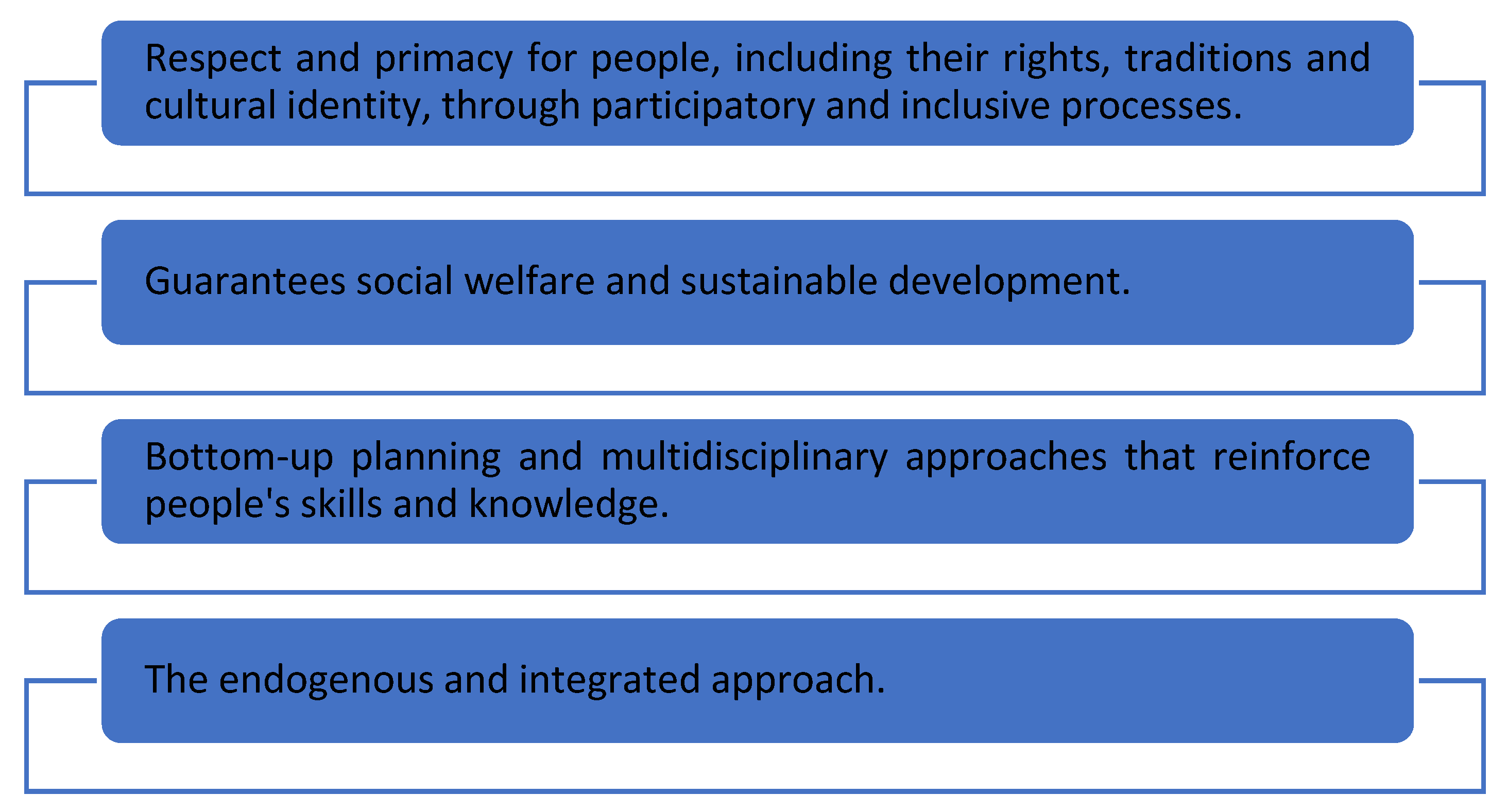
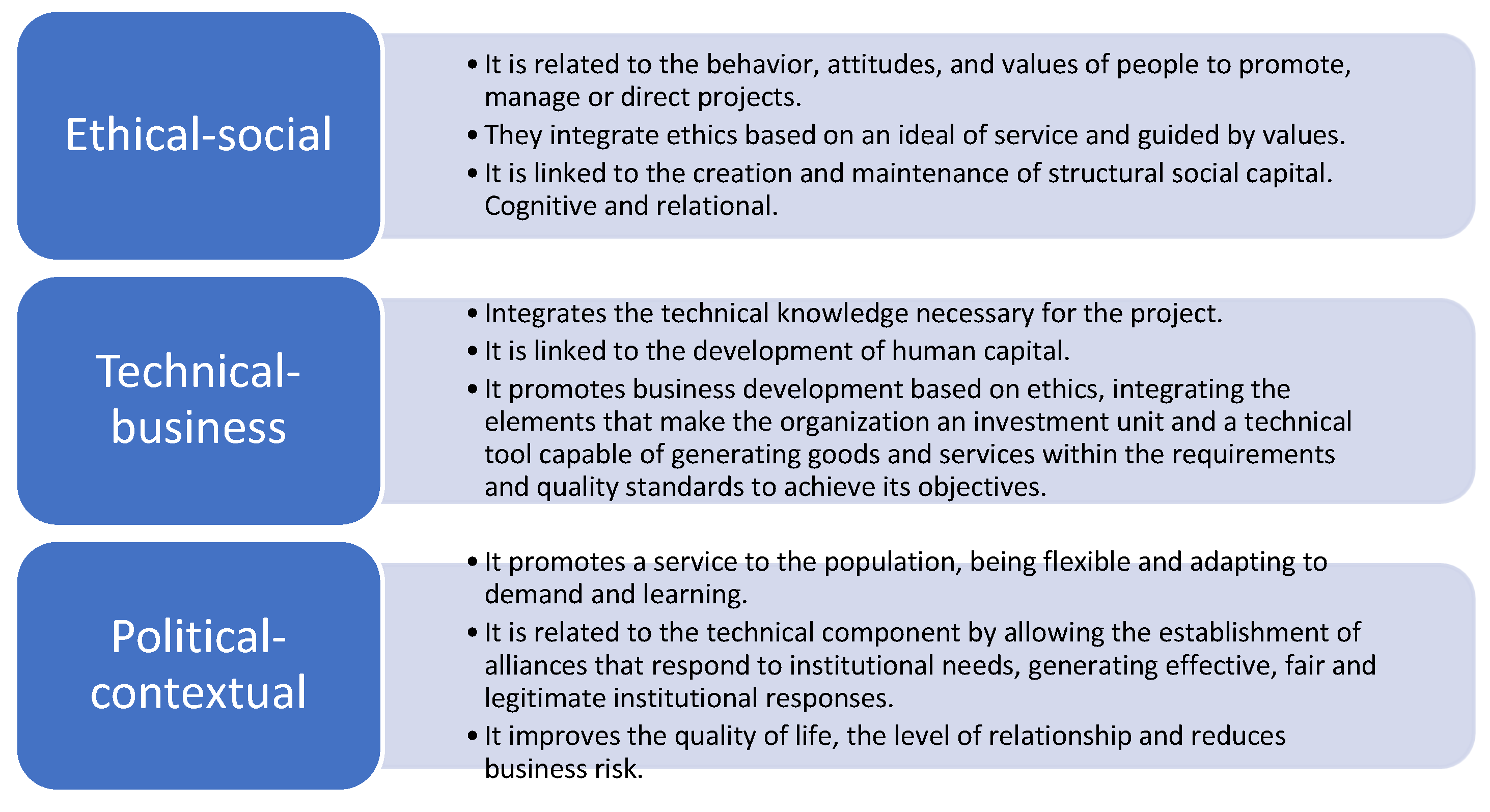
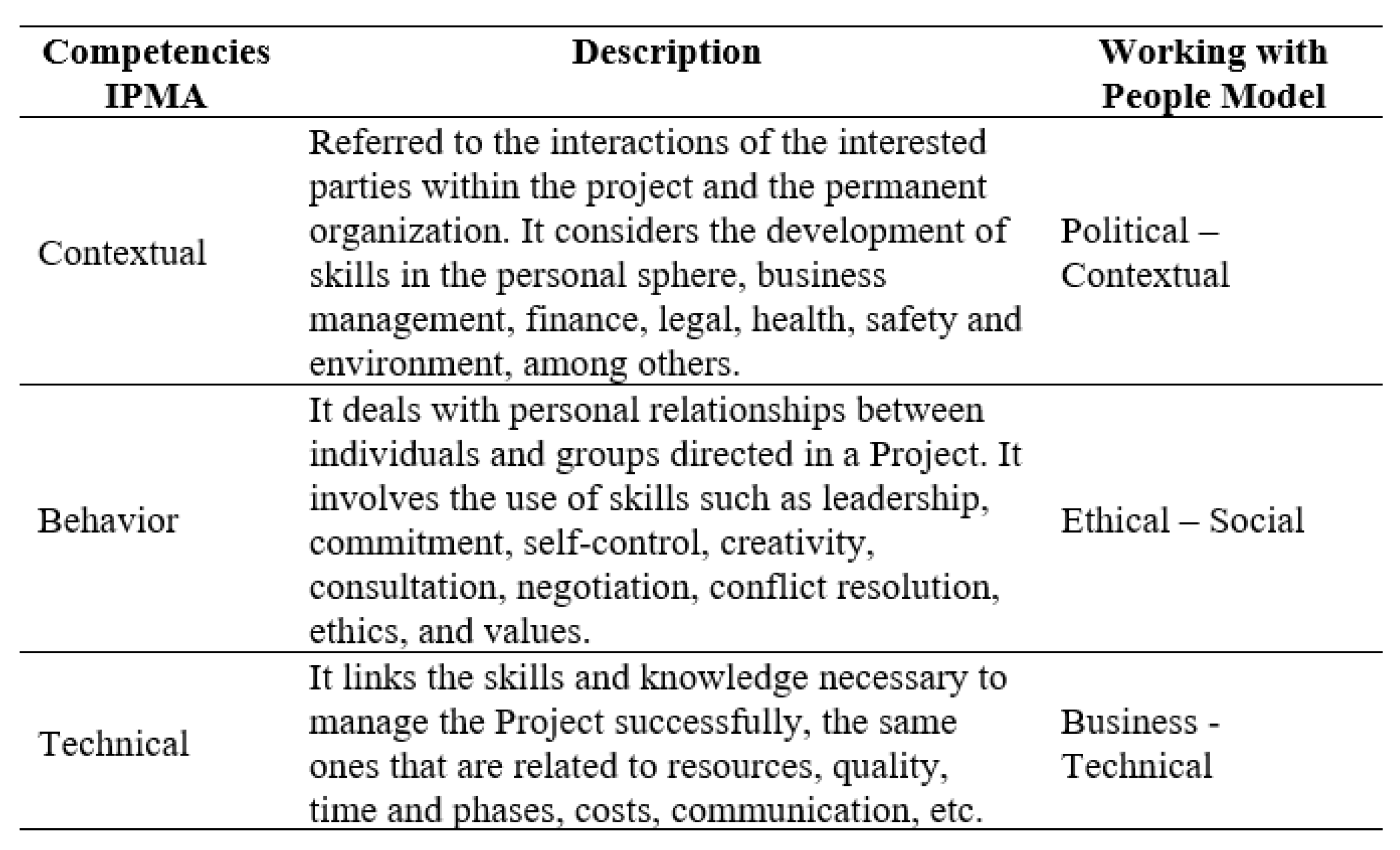
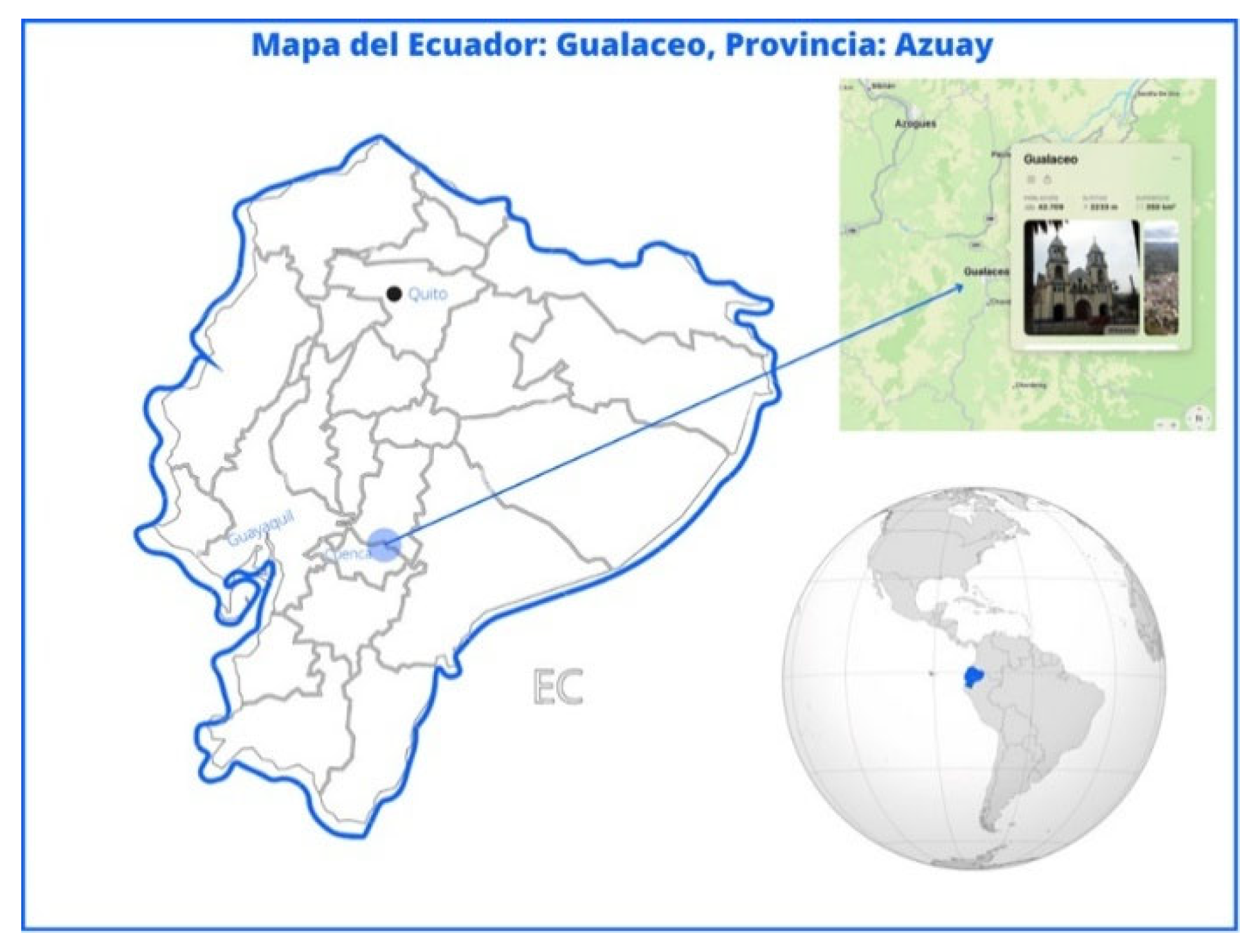
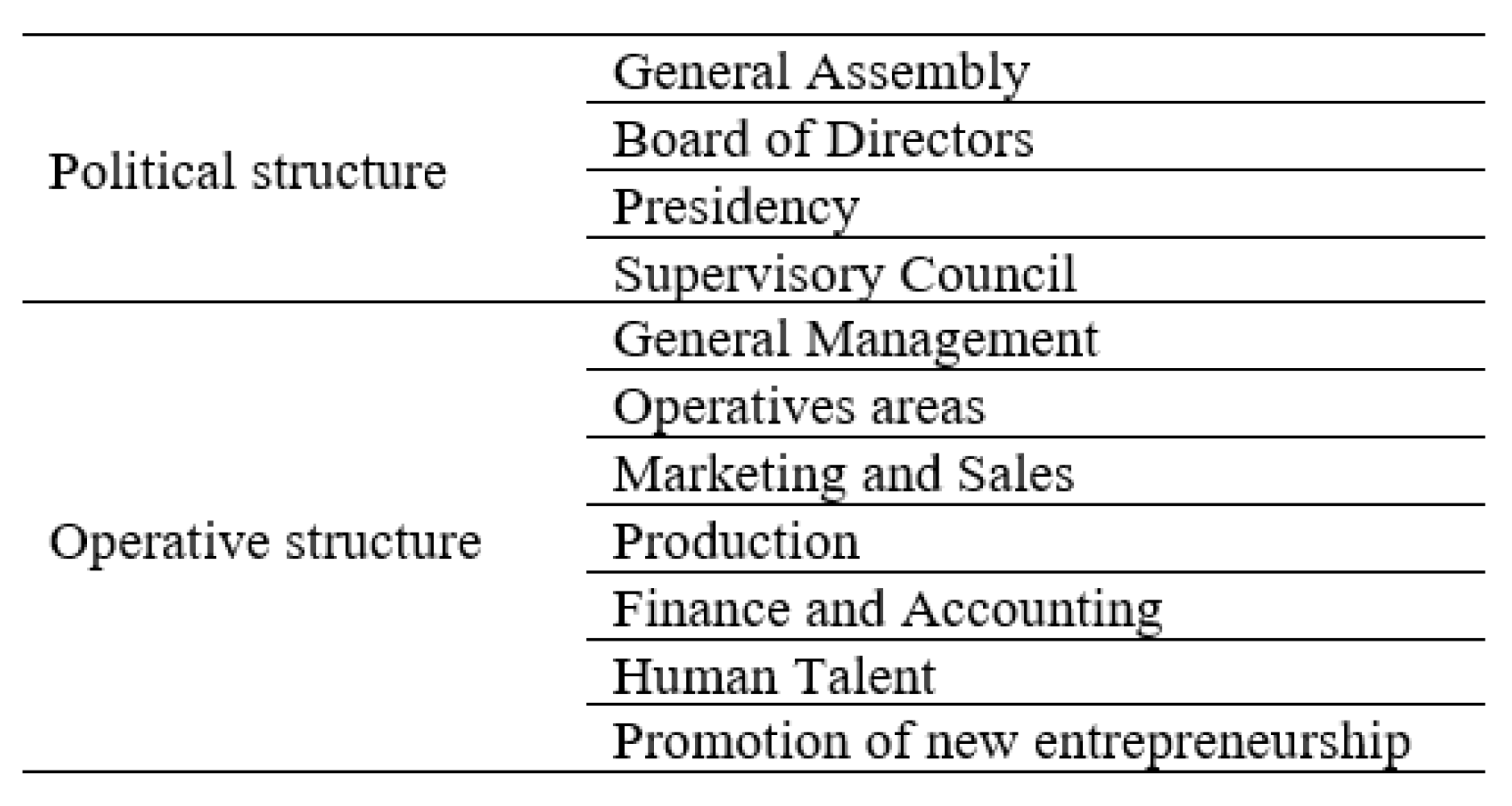
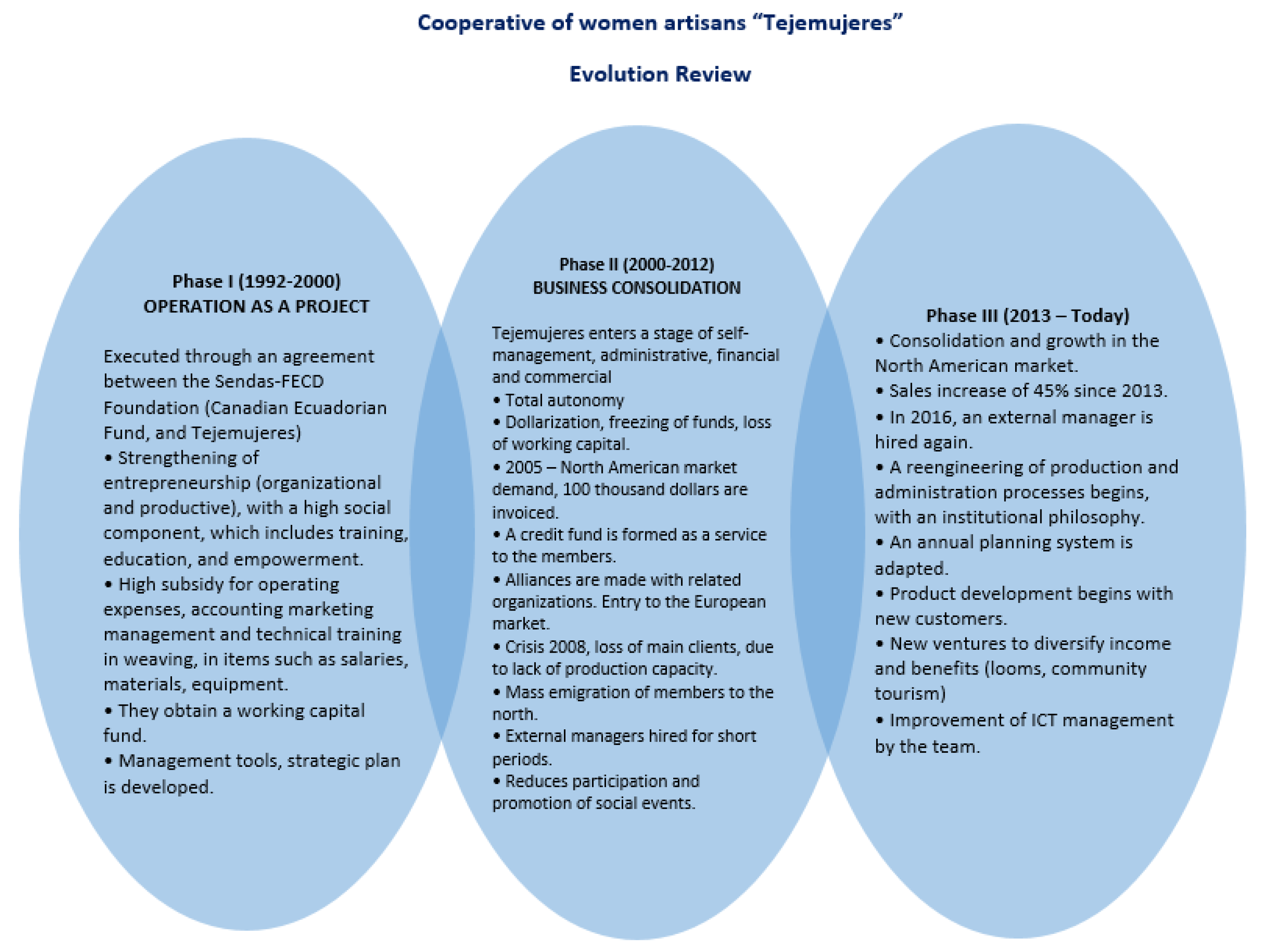
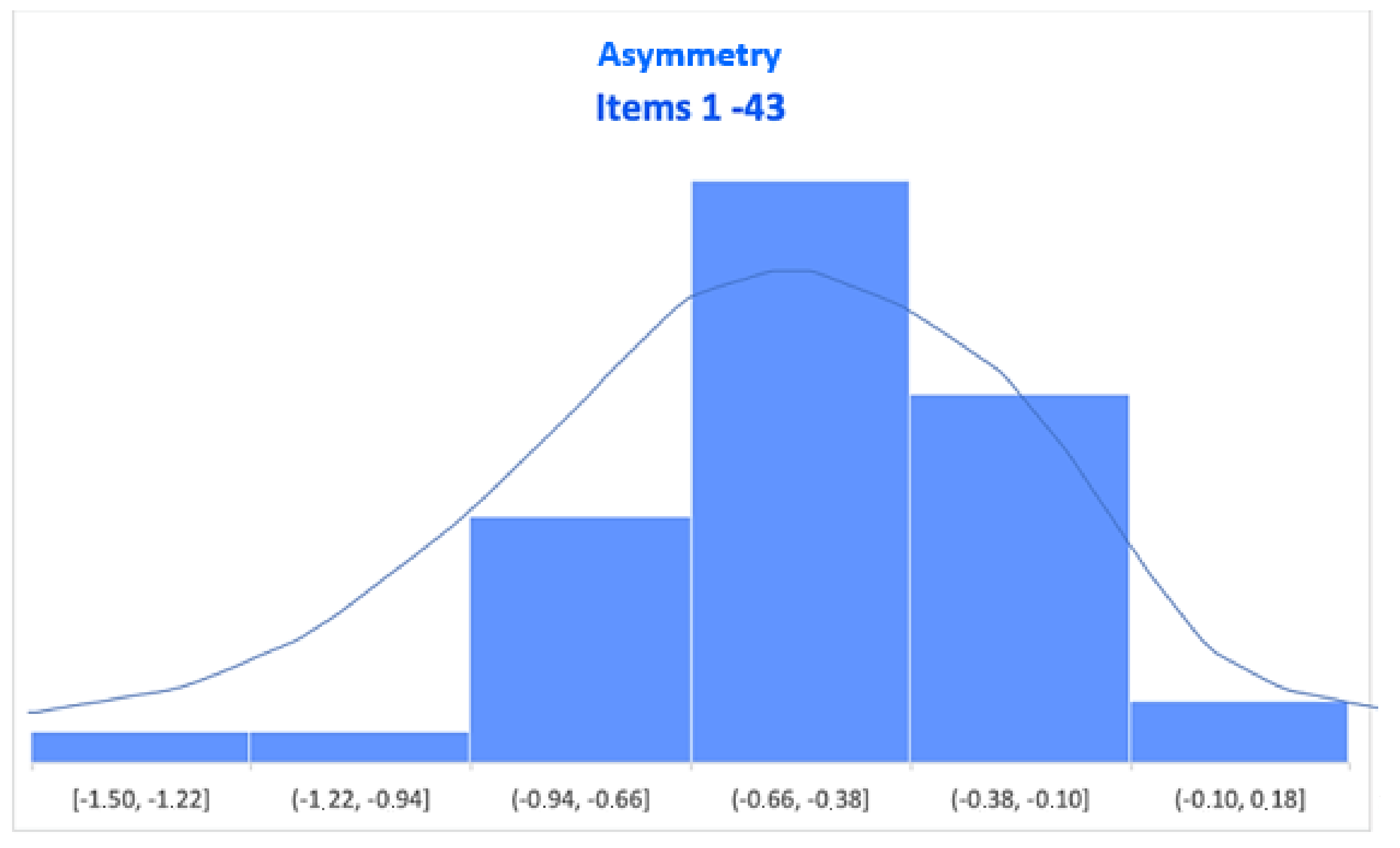
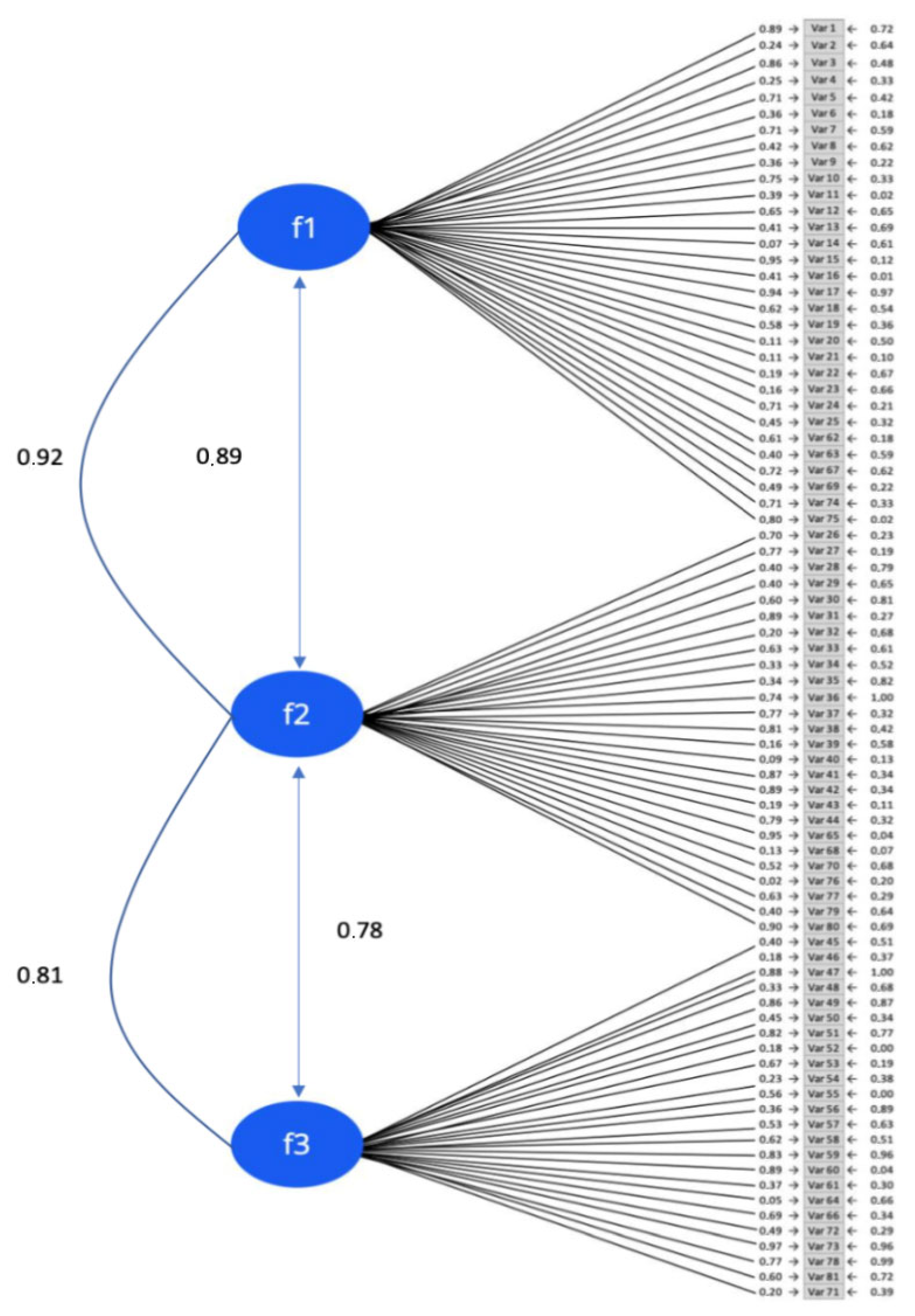
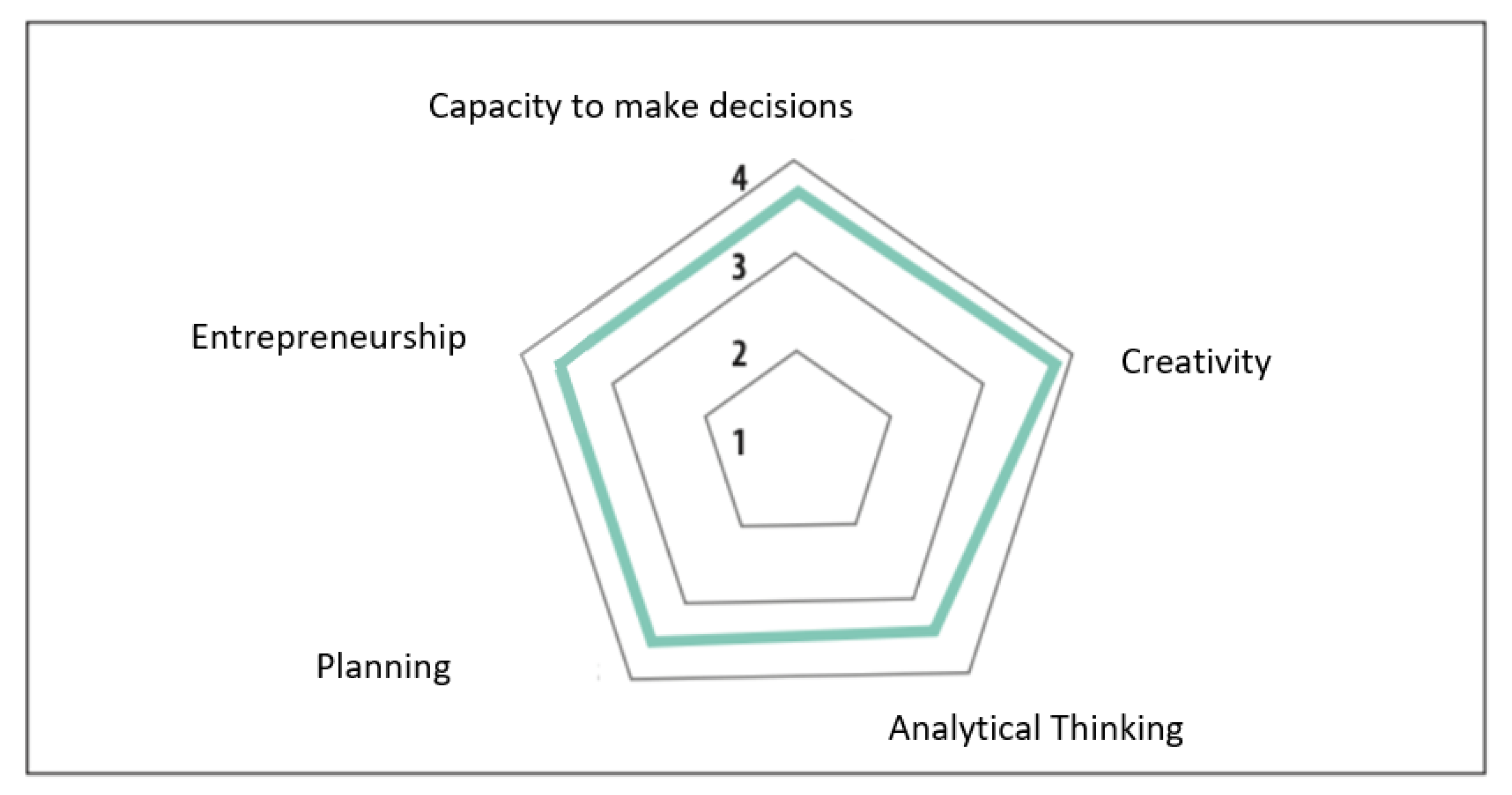
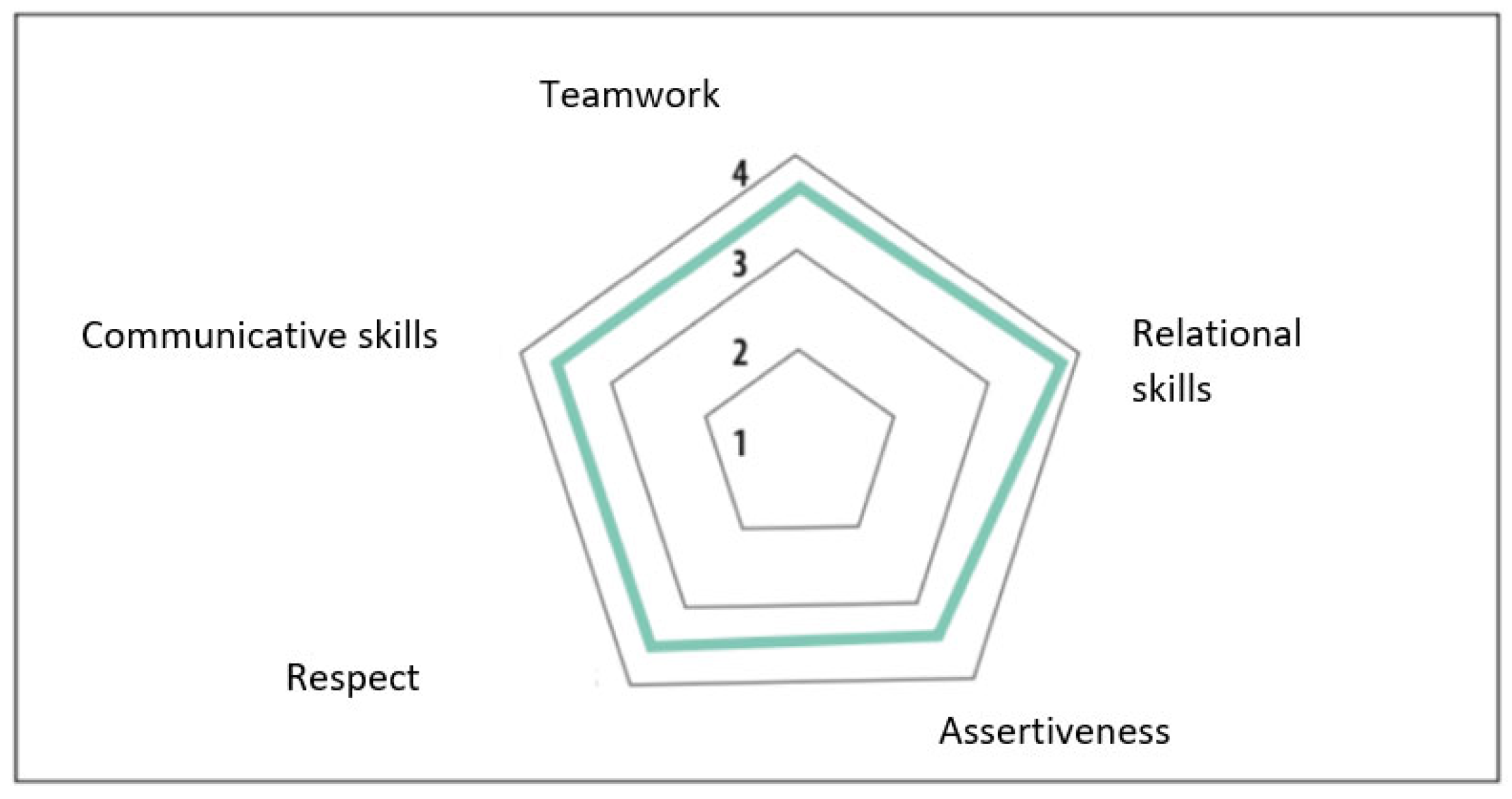
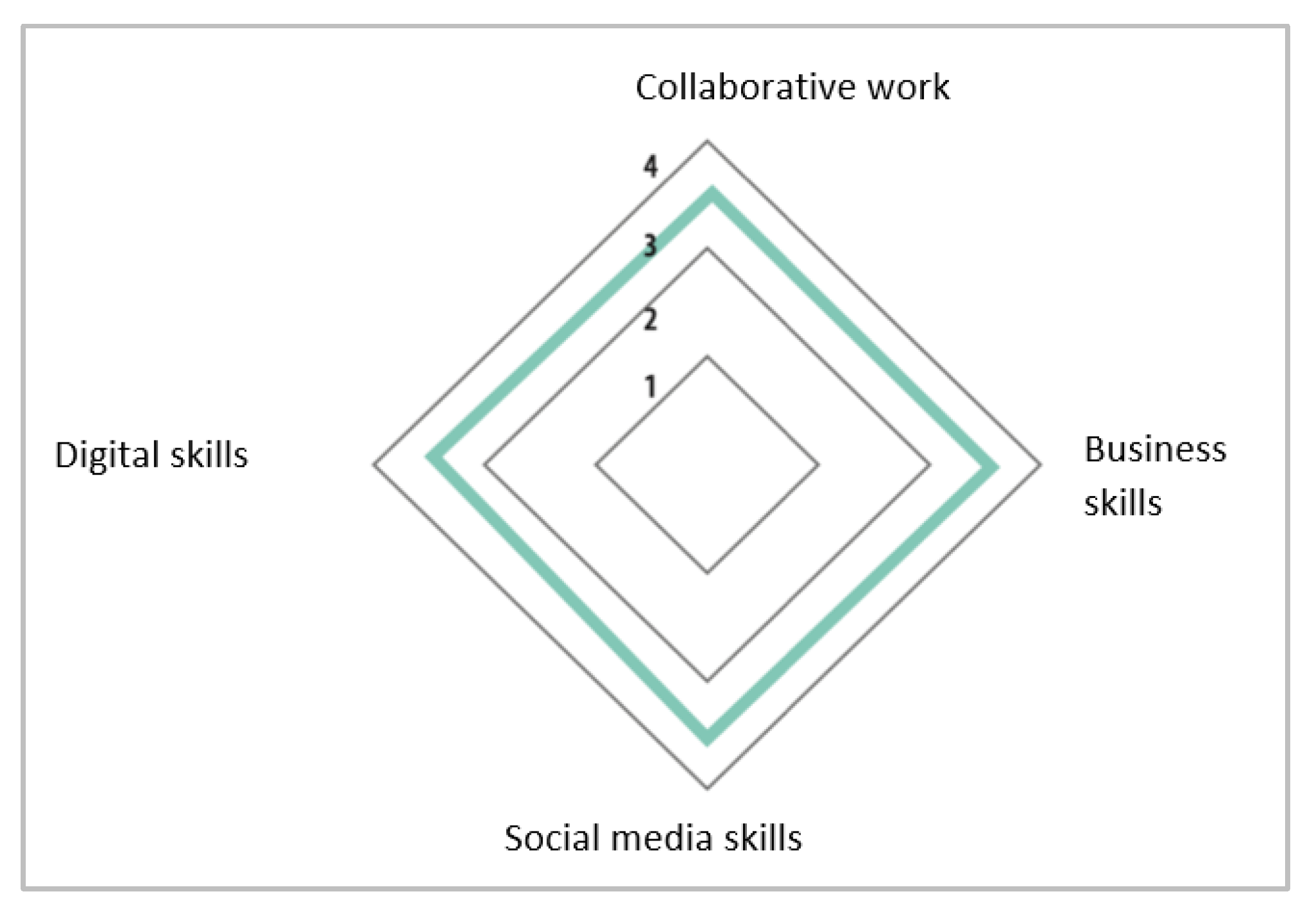
| Factor | Cronbach’s Alpha |
|---|---|
| Business technician | 0.81 |
| Social Ethics | 0.92 |
| Political-contextual | 0.91 |
| Competencies | Alpha Cronbach | Items |
|---|---|---|
| Communication | 0.91 | 6 |
| Leadership | 0.85 | 6 |
| Appreciation of values and ethics. | 0.85 | 7 |
| Creativity | 0.82 | 3 |
| Teamwork | 0.78 | 6 |
| Crisis and conflict negotiation | 0.76 | 6 |
| Planning | 0.72 | 4 |
| Teamwork | 3.23 |
| Communication | 3.11 |
| Appreciation of values and ethics | 3.07 |
| Crisis and conflict negotiation | 3.06 |
| Creativity | 3.01 |
| Planning | 2.99 |
| Leadership | 2.95 |
| Technical Dimension | Dimension Social | Context Dimension | ||
|---|---|---|---|---|
| Total Sample | 5.71 (1.16) | 4.16 (1.02) | 5.01 (1.61) | |
| Age (ranges) | From 24 to 35 years old | 5.56 (1.31) | 3.14 (1.33) | 4.83 (1.28) |
| From 36 to 50 years old | 5.67 (1.09) | 5.44 (1.93) | 3.16 (1.89) | |
| From 50 to 65 years old | 4.79 (1.39) | 3.04 (1.83) | 4.11 (1.20) | |
| t(df) | 0.598 (81) * | 0.427 (81) * | 0.278 (81) * | |
| Main economic activity | Agriculture | 4.19 (1.48) | 5.78 (1.04) | 3.49 (1.9) |
| Craft | 3.91 (1.69) | 4.96 (1.91) | 4.15 (1.14) | |
| Others | 3.57 (1.34) | 3.01 (1.37) | 3.66 (1.2) | |
| F(df) | 0.417 (81) | 0.581 (81) * | 0.145 (81) | |
| Level of schooling | With Baccalaureate | 3.05 (1.81) | 5.14 (1.96) | 4.36 (1.43) |
| Without Baccalaureate | 5.18 (1.92) | 5.6 (1.65) | 4.57 (1.08) | |
| t(df) | 0.342 (81) ** | 0.247 (81) * | 0.267 (81) |
| Political-Contextual Dimension | ||||||
|---|---|---|---|---|---|---|
| Analytical Thinking | Creativity | Entrepreneurship | Planning | Capacity to Make Decisions | ||
| Total Sample | ||||||
| Age (ranges) | From 24 to 35 years old | 5.16 (1.76) | 4.03 (1.01) | 4.75 (1.53) | 2.67 (1.1) | 1.02 (1.94) |
| From 36 to 50 years old | 5.27 (1.57) | 5.04 (1.67) | 4.55 (1.02) | 1.52 (2) | 2.66 (1.32) | |
| From 50 to 65 years old | 1.41 (1.18) | 2.01 (1.35) | 4.69 (1.22) | 2.5 (1.35) | 2.19 (1.51) | |
| t(df) | 3.775 (85) * | 2.467 (85) | 0.201 (85) | 0.822 (85) | 0.159 (85) | |
| Main economic activity | Agriculture | 2.48 (1.27) | 3.17 (1.48) | 5.58 (1.81) | 4.02 (1.35) | 1.9 (1.38) |
| Craft | 5.65 (1.63) | 2.79 (1.07) | 5.56 (1.92) | 2.27 (1.37) | 4.56 (1.01) | |
| Others | 5.59 (1.68) | 3.77 (1.04) | 4.42 (1.98) | 2.72 (1.16) | 3.69 (1.87) | |
| F(df) | 3.497 (85) * | 0.511 (85) | 3.824 (85) | 0.33 (85) | 0.81 (85) | |
| Level of schooling | With Baccalaureate | 2.84 (1.74) | 5.68 (1.57) | 1.31 (1.39) | 1.49 (1.76) | 4.26 (1.07) |
| Without Baccalaureate | 1.23 (1.93) | 3.84 (1.72) | 2.83 (1.41) | 4.34 (1.05) | 4.63 (1.17) | |
| t(df) | 3.586 (85) * | 4.466 (85) * | 0.409 (85) | 0.755 (85) | 0.639 (85) | |
| Ethical-Social Dimension | ||||||
|---|---|---|---|---|---|---|
| Self-Esteem | Self-Efficacy | Personal Autonomy | Empathy | Optimism | ||
| Total Sample | ||||||
| Age (ranges) | From 24 to 35 years old | 5.96 (1.31) | 1.14 (1.33) | 1.83 (1.28) | 1.69 (1.28) | 2.99 (1.12) |
| From 36 to 50 years old | 2.67 (1.09) | 3.44 (1.93) | 3.15 (1.89) | 1.36 (1.06) | 5.79 (1.06) | |
| From 50 to 65 years old | 4.79 (1.39) | 2.04 (1.83) | 4.12 (1.12) | 2.46 (1.45) | 4.26 (1.24) | |
| t(df) | 0.508 (85) | 0.438 (85) | 0.208 (85) | 0.852 (85) | 0.419 (85) | |
| Main economic activity | Agriculture | 4.19 (1.48) | 5.78 (1.04) | 3.49 (1.9) | 1.01 (1.98) | 5.29 (1.05) |
| Craft | 2.91 (1.69) | 1.96 (1.91) | 4.55 (1.14) | 1.12 (1.75) | 3.28 (1.1) | |
| Others | 4.57 (1.34) | 3.01 (1.37) | 3.26 (1.2) | 5.95 (1.87) | 3.15 (1.88) | |
| F(df) | 0.438 (85) | 0.577 (85) | 0.345 (85) | 0.616 (85) | 0.246 (85) | |
| Level of schooling | With Baccalaureate | 2.05 (1.81) | 5.14 (1.96) | 4.36 (1.43) | 3.97 (1.83) | 3.46 (1.77) |
| Without Baccalaureate | 5.18 (1.92) | 1.6 (1.65) | 4.57 (1.08) | 1.96 (1.07) | 5.38 (1.46) | |
| t(df) | 0.342 (85) | 0.247 (85) | 0.267 (85) | 0.358 (85) | 0.447 (85) | |
| Technical-Business Dimension | |||||
|---|---|---|---|---|---|
| Business Skills | Digital Skills | Social Media Skills | Collaborative Work | ||
| Total Sample | |||||
| Age (ranges) | From 24 to 35 years old | 1.02 (1.22) | 3.88 (1.63) | 4.48 (1.78) | 1.27 (1.17) |
| From 36 to 50 years old | 5.89 (1.5) | 3.79 (1.81) | 4.87 (1.33) | 5.59 (1.27) | |
| From 50 to 65 years old | 2.11 (1.12) | 4.63 (1.26) | 5.7 (1.93) | 3.67 (1.28) | |
| t(df) | 0.337 (85) | 0.82 (85) | 0.666 (85) | 0.034 (85) | |
| Main economic activity | Agriculture | 1.25 (1.73) | 3.17 (1.76) | 5.27 (1.5) | 1.68 (1.74) |
| Craft | 3.81 (1.13) | 3.01 (1.89) | 5.51 (1.81) | 3.13 (1.51) | |
| Others | 4.72 (1.01) | 4.32 (1.59) | 5.7 (1.44) | 2.74 (1.74) | |
| F(df) | 0.681 (85) | 0.144 (85) | 0.565 (85) | 0.396 (85) | |
| Level of schooling | With Baccalaureate | 4.2 (1.42) | 3.64 (1.92) | 2.91 (1.77) | 3.32 (1.05) |
| Without Baccalaureate | 1.48 (1.79) | 1.21 (1.12) | 2.35 (1.91) | 1.72 (1.38) | |
| t(df) | 0.354 (85) | 0.605 (85) | 0.85 (85) | 0.414 (85) | |
Publisher’s Note: MDPI stays neutral with regard to jurisdictional claims in published maps and institutional affiliations. |
© 2022 by the authors. Licensee MDPI, Basel, Switzerland. This article is an open access article distributed under the terms and conditions of the Creative Commons Attribution (CC BY) license (https://creativecommons.org/licenses/by/4.0/).
Share and Cite
Ortuño, M.; De los Ríos, I.; Sastre-Merino, S. The Development of Skills as a Key Factor of the Cooperative System: Analysis of the Cooperative of Artisan Women Tejemujeres-Gualaceo-Ecuador from the WWP Model. Sustainability 2022, 14, 16233. https://doi.org/10.3390/su142316233
Ortuño M, De los Ríos I, Sastre-Merino S. The Development of Skills as a Key Factor of the Cooperative System: Analysis of the Cooperative of Artisan Women Tejemujeres-Gualaceo-Ecuador from the WWP Model. Sustainability. 2022; 14(23):16233. https://doi.org/10.3390/su142316233
Chicago/Turabian StyleOrtuño, Mauricio, Ignacio De los Ríos, and Susana Sastre-Merino. 2022. "The Development of Skills as a Key Factor of the Cooperative System: Analysis of the Cooperative of Artisan Women Tejemujeres-Gualaceo-Ecuador from the WWP Model" Sustainability 14, no. 23: 16233. https://doi.org/10.3390/su142316233
APA StyleOrtuño, M., De los Ríos, I., & Sastre-Merino, S. (2022). The Development of Skills as a Key Factor of the Cooperative System: Analysis of the Cooperative of Artisan Women Tejemujeres-Gualaceo-Ecuador from the WWP Model. Sustainability, 14(23), 16233. https://doi.org/10.3390/su142316233








